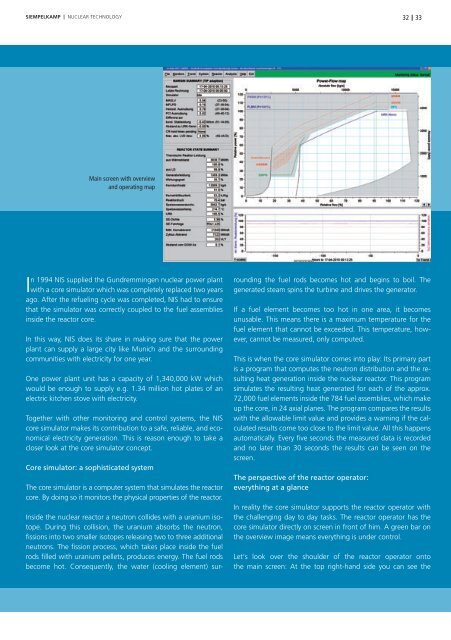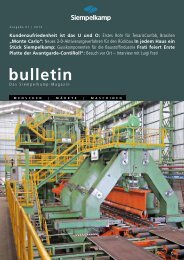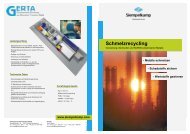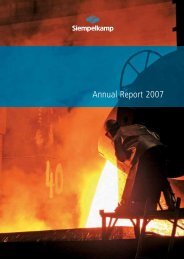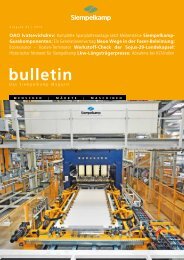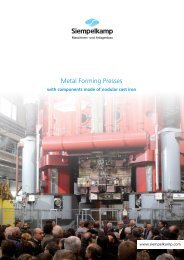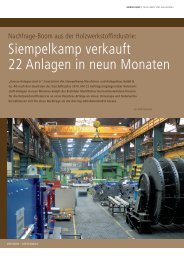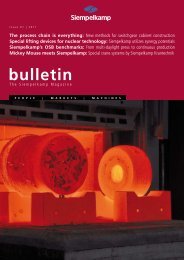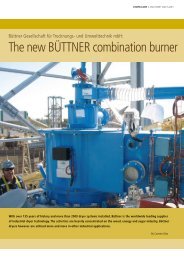Bulletin 2/2010 - Siempelkamp NIS
Bulletin 2/2010 - Siempelkamp NIS
Bulletin 2/2010 - Siempelkamp NIS
You also want an ePaper? Increase the reach of your titles
YUMPU automatically turns print PDFs into web optimized ePapers that Google loves.
SIEMPELKAMP | NUCLEAR TECHNOLOGY<br />
Main screen with overview<br />
and operating map<br />
In 1994 <strong>NIS</strong> supplied the Gundremmingen nuclear power plant<br />
with a core simulator which was completely replaced two years<br />
ago. After the refueling cycle was completed, <strong>NIS</strong> had to ensure<br />
that the simulator was correctly coupled to the fuel assemblies<br />
inside the reactor core.<br />
In this way, <strong>NIS</strong> does its share in making sure that the power<br />
plant can supply a large city like Munich and the surrounding<br />
communities with electricity for one year.<br />
One power plant unit has a capacity of 1,340,000 kW which<br />
would be enough to supply e.g. 1.34 million hot plates of an<br />
electric kitchen stove with electricity.<br />
Together with other monitoring and control systems, the <strong>NIS</strong><br />
core simulator makes its contribution to a safe, reliable, and economical<br />
electricity generation. This is reason enough to take a<br />
closer look at the core simulator concept.<br />
Core simulator: a sophisticated system<br />
The core simulator is a computer system that simulates the reactor<br />
core. By doing so it monitors the physical properties of the reactor.<br />
Inside the nuclear reactor a neutron collides with a uranium isotope.<br />
During this collision, the uranium absorbs the neutron,<br />
fi ssions into two smaller isotopes releasing two to three additional<br />
neutrons. The fi ssion process, which takes place inside the fuel<br />
rods fi lled with uranium pellets, produces energy. The fuel rods<br />
become hot. Consequently, the water (cooling element) sur-<br />
rounding the fuel rods becomes hot and begins to boil. The<br />
generated steam spins the turbine and drives the generator.<br />
If a fuel element becomes too hot in one area, it becomes<br />
unusable. This means there is a maximum temperature for the<br />
fuel element that cannot be exceeded. This temperature, however,<br />
cannot be measured, only computed.<br />
This is when the core simulator comes into play: Its primary part<br />
is a program that computes the neutron distribution and the resulting<br />
heat generation inside the nuclear reactor. This program<br />
simulates the resulting heat generated for each of the approx.<br />
72,000 fuel elements inside the 784 fuel assemblies, which make<br />
up the core, in 24 axial planes. The program compares the results<br />
with the allowable limit value and provides a warning if the calculated<br />
results come too close to the limit value. All this happens<br />
automatically. Every fi ve seconds the measured data is recorded<br />
and no later than 30 seconds the results can be seen on the<br />
screen.<br />
The perspective of the reactor operator:<br />
everything at a glance<br />
In reality the core simulator supports the reactor operator with<br />
the challenging day to day tasks. The reactor operator has the<br />
core simulator directly on screen in front of him. A green bar on<br />
the overview image means everything is under control.<br />
Let‘s look over the shoulder of the reactor operator onto<br />
the main screen: At the top right-hand side you can see the<br />
32<br />
33


